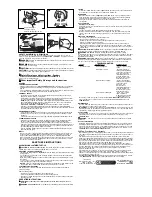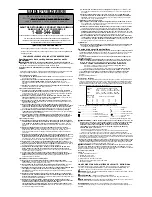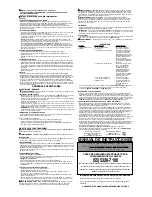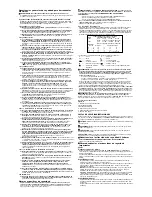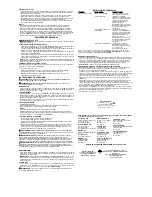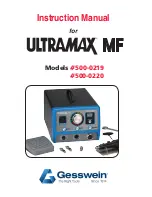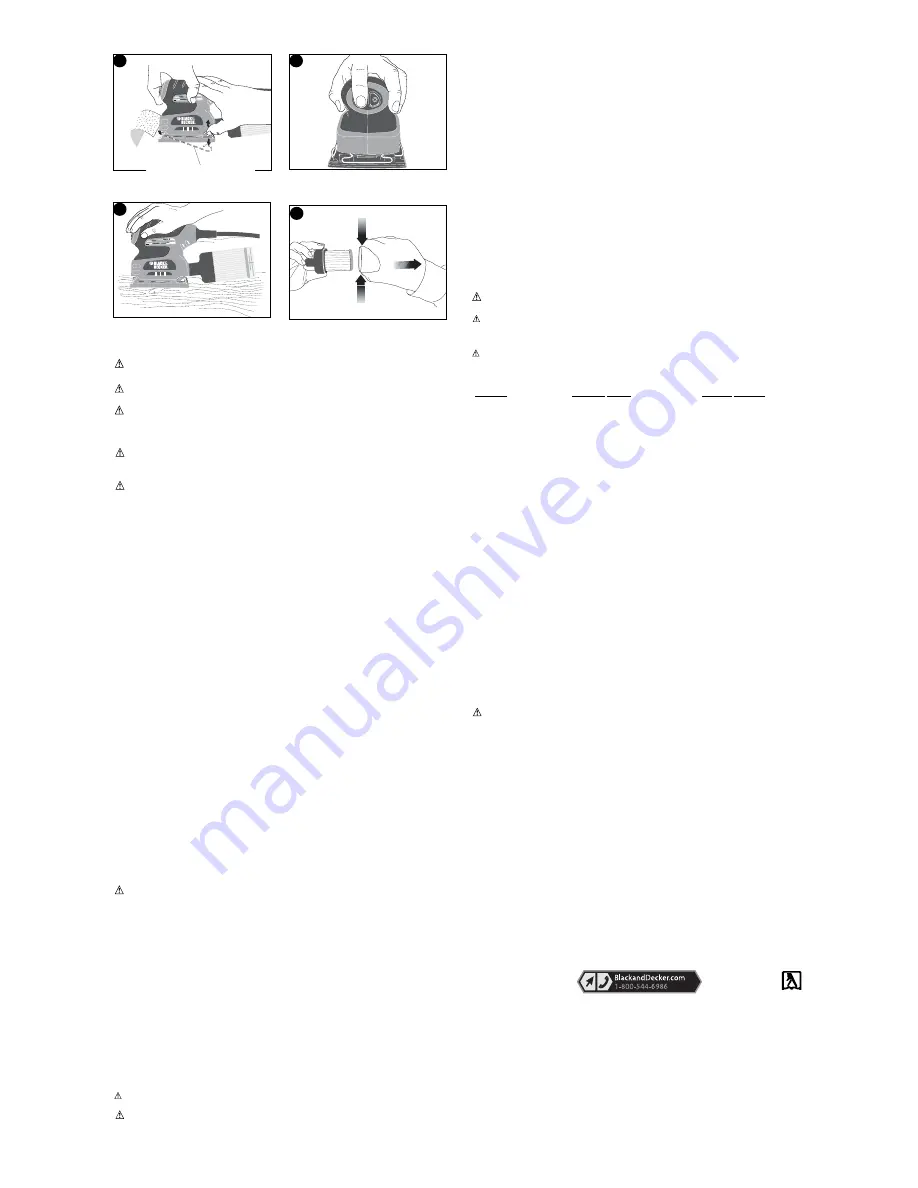
SWITCH
To turn the tool ON, hold it as shown in f
igure C
and push the portion of the switch marked
"I". To turn the tool off, push the portion of the switch marked "O".
OPERATION
Grasp the sander as shown in
figure D
and turn it ON. Move it in long, sweeping strokes
along the surface, letting it do the work. Pushing down on the tool while sanding actually
slows the removal rate and produces an inferior quality finish.
Check your work often. Sander is capable of removing material rapidly especially with
coarse paper.
DUST CANISTER
Attaching and removing:
Fit the dust canister over the dust extraction outlet. To remove the canister, pull it out to the
rear and off the outlet.
Emptying:
The dust canister should be emptied after every 5 minutes of sanding.
Remove canister and shake out debris over a trash can. The clear plastic housing of the
canister can be removed for cleaning by pressing in on the release buttons as shown in
figure E.
HINTS FOR OPTIMUM USE
• Do not place your hands over the ventilation slots.
• Do not exert too much pressure on the tool.
• Regularly check the condition of the sanding sheet. Replace when necessary.
• Always sand with the grain of the wood.
• When sanding new layers of paint before applying another layer, use extra fine grit.
• On very uneven surfaces, or when removing layers of paint, start with a coarse grit. On
other surfaces, start with a medium grit. In both cases, gradually change to a fine grit for a
smooth finish.
CAUTION: Respiratory hazard.
Never operate this tool
for wood sanding
unless the
dust canister is in place. Sanding dust exhaust may create a breathing hazard.
WARNING: Fire hazard.
Collected sanding dust from sanding surface coatings
(polyurethane, linseed oil, etc.) can self-ignite in sander dust canister or elsewhere and cause
fire. To reduce risk, empty canister frequently and strictly follow sander manual and coating
manufacturer's instructions.
WARNING: Fire hazard.
When working on metal surfaces, do not use the dust canister
because sparks are generated. Wear safety glasses and a dust mask. Due to the danger of
fire, do not use your sander to sand magnesium surfaces. Do not use for wet sanding.
MAINTENANCE
Use only mild soap and damp cloth to clean the tool. Never let any liquid get inside the tool;
never immerse any part of the tool into a liquid.
IMPORTANT:
To assure product SAFETY and RELIABILITY, repairs, maintenance and
adjustment should be performed by authorized service centers or other qualified service
organizations, always using identical replacement parts.
ACCESSORIES
Recommended accessories for use with your tool are available from your local dealer or
authorized service center. If you need assistance regarding accessories, please call:
1-800-544-6986.
WARNING:
The use of any accessory not recommended for use with this tool could be
hazardous.
Service Information
All Black & Decker Service Centers are staffed with trained personnel to provide customers
with efficient and reliable power tool service. Whether you need technical advice, repair, or
genuine factory replacement parts, contact the Black & Decker location nearest you. To find
your local service location, refer to the yellow page directory under "Tools—Electric" or call:
1-800-544-6986 or visit www.blackanddecker.com
Full Two-Year Home Use Warranty
Black & Decker (U.S.) Inc. warrants this product for two years against any defects in material
or workmanship. The defective product will be replaced or repaired at no charge in either of
two ways.
The first, which will result in exchanges only, is to return the product to the retailer from
whom it was purchased (provided that the store is a participating retailer). Returns should be
made within the time period of the retailer’s policy for exchanges (usually 30 to 90 days after
the sale). Proof of purchase may be required. Please check with the retailer for their specific
return policy regarding returns that are beyond the time set for exchanges.
The second option is to take or send the product (prepaid) to a Black & Decker owned or
authorized Service Center for repair or replacement at our option. Proof of purchase may be
required. Black & Decker owned and authorized Service Centers are listed under "Tools-
Electric" in the yellow pages of the phone directory and available on our website
www.blackanddecker.com.
This warranty does not apply to accessories. This warranty gives you specific legal rights
and you may have other rights which vary from state to state. Should you have any
questions, contact the manager of your nearest Black & Decker Service Center. This product
is not intended for commercial use.
Free Warning Label Replacement:
If your warning labels become illegible or are missing,
call
1-800-544-6986
for a free replacement.st Black & Decker Service Center.
See ‘Tools-Electric’
– Yellow Pages –
for Service & Sales
Imported by
Black & Decker (U.S.) Inc.,
701 E. Joppa Rd.
Towson, MD 21286 U.S.A.
SAFETY GUIDELINES - DEFINITIONS
It is important for you to read and understand this manual. The information it contains
relates to protecting YOUR SAFETY and PREVENTING PROBLEMS. The symbols below
are used to help you recognize this information.
DANGER:
Indicates an imminently hazardous situation which, if not avoided, will result
in death or serious injury.
WARNING:
Indicates a potentially hazardous situation which, if not avoided, could
result in death or serious injury.
CAUTION:
Indicates a potentially hazardous situation which, if not avoided, may result
CAUTION:
Used without the safety alert symbol indicates a potentially hazardous situation
which, if not avoided, may result in property damage.
Safety Warnings and Instructions: Sanders
•
ALWAYS USE PROPER EYE AND RESPIRATORY PROTECTION.
• Clean your tool out periodically.
Other Important Safety Warnings and Instructions
Sanding
SANDING LEAD BASED PAINT
Sanding of lead based paint is NOT RECOMMENDED due to the difficulty of controlling the
contaminated dust. The greatest danger of lead poisoning is to children and pregnant
women.
Since it is difficult to identify whether or not a paint contains lead without a chemical analysis,
we recommend the following precautions when sanding any paint:
PERSONAL SAFETY
• No children or pregnant women should enter the work area where the paint sanding is
being done until all clean up is completed.
• A dust mask or respirator should be worn by all persons entering the work area. The filter
should be replaced daily or whenever the wearer has difficulty breathing.
•
NOTE:
Only those dust masks suitable for working with lead paint dust and fumes should
be used. Ordinary painting masks do not offer this protection. See your local hardware
dealer for the proper (NIOSH approved) mask.
• NO EATING, DRINKING or SMOKING should be done in the work area to prevent
ingesting contaminated paint particles. Workers should wash and clean up BEFORE
eating, drinking or smoking. Articles of food, drink, or smoking should not be left in the work
area where dust would settle on them.
ENVIRONMENTAL SAFETY
• Paint should be removed in such a manner as to minimize the amount of dust generated.
• Areas where paint removal is occurring should be sealed with plastic sheeting of 4 mils
thickness.
• Sanding should be done in a manner to reduce tracking of paint dust outside the work area.
CLEANING AND DISPOSAL
• All surfaces in the work area should be vacuumed and thoroughly cleaned daily for the
duration of the sanding project. Vacuum filter bags should be changed frequently.
• Plastic drop cloths should be gathered up and disposed of along with any dust chips or
other removal debris. They should be placed in sealed refuse receptacles and disposed of
through regular trash pick-up procedures. During clean up, children and pregnant women
should be kept away from the immediate work area.
• All toys, washable furniture and utensils used by children should be washed thoroughly
before being used again.
Motor
Be sure your power supply agrees with nameplate marking. 120 Volts AC only means your
tool will operate on standard 60 Hz household power. Do not operate AC tools on DC. A
rating of 120 volts AC/DC means that you tool will operate on standard 60 Hz AC or DC
power. This information is printed on the nameplate. Lower voltage will cause loss of power
and can result in over-heating. All Black & Decker tools are factory-tested; if this tool does
not operate, check the power supply.
SAVE THESE INSTRUCTIONS
ASSEMBLY/ADJUSTMENT SET-UP
CAUTION:
To reduce the risk of injury
, turn off and unplug the tool before making any
adjustments or removing or installing attachments or accessories.
ATTACHING 1/4 SHEET SANDPAPER
• Lift clamps up with your thumb,
(figure B)
. Rotate the clamp lever downward until the clamp
is fully opened.
• Lay sandpaper on a flat surface and, centering the pad of the unit, press the sander down
firmly onto the paper.
• Wrap ends of the sandpaper around ends of the sander pad and clamp them in place using
the clamps.
• To close clamps, rotate clamp handles back up as far as they will go and lock them in place.
Stretch sandpaper as tight as possible when clamping.
NOTE:
On new tools the sandpaper may be difficult to install because of the stiffness of the
sanding pad. This condition will improve as the pad compresses over time.
PUNCHING SANDING SHEETS
The paper punch is used for punching dust extraction holes in sanding sheets without
pre-punched holes.
Attach a sanding sheet.
• Hold the tool in position directly above the paper punch.
• Press the tool with the sanding base down into the paper punch.
• Take the tool off the paper punch and check whether the holes in the sanding sheet have
been fully pierced.
OPERATING INSTRUCTIONS
WARNING: To reduce the risk of injury, let the tool work at its own pace. Do not
overload
.
WARNING: Shock hazard.
Under no circumstances should this product be used near water.
TROUBLESHOOTING
Problem
Possible Cause
Possible Solution
• Unit will not start.
• Cord not plugged in.
• Plug tool into a working
outlet.
• Circuit fuse is blown.
• Replace circuit fuse.
(If the product repeatedly
causes the circuit fuse to
blow, discontinue use
immediately and have it
serviced at a Black &
Decker service center or
authorized servicer.)
• Circuit breaker is tripped.
• Reset circuit breaker.
(If the product repeatedly
causes the circuit
breaker to trip,
discontinue use
immediately and have it
serviced at a Black &
Decker service center or
authorized servicer.)
• Cord or switch is damaged.
• Have cord or switch
replaced at Black
& Decker Service Center
or Authorized Servicer
For assistance with your product, visit our website
www.blackanddecker.com
for the
location of the service center nearest you or call the BLACK & DECKER help line at
1-800-544-6986.
Paper clamp lever
Levier de la pince
Palanca del sujetador de lija
B
C
D
E


